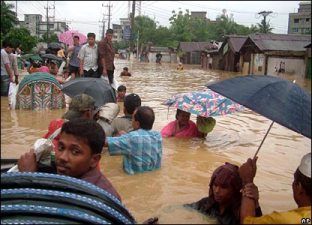 DHAKA, 25 August 2009 (IRIN) – Heavy monsoon rains, which arrived much later than normal this year, have stranded hundreds of thousands in southeastern Bangladesh and threatened livelihoods, say local officials.
DHAKA, 25 August 2009 (IRIN) – Heavy monsoon rains, which arrived much later than normal this year, have stranded hundreds of thousands in southeastern Bangladesh and threatened livelihoods, say local officials.
According to the Flood Forecasting and Warning Centre (FFWC), there are nine places where river levels are 3-125cm above the danger level. If current rainfall persists – as the FFWC thinks it will – by the end of August over 30 percent of the country could be inundated, the forecast warns.
The FFWC blames the flooding on unusually heavy rainfall combined with drift water flooding in from the Assam and Meghalaya regions of India.
Kurigram, Rajbari, Sirajganj and Rangpur districts in Rajshahi Division, and Rajbari in Dhaka Division are the worst affected. Bangladesh has six divisions.
In Kurigram District, over 200,000 people in seven sub-districts were left stranded by floodwaters, with over 30,000 hectares of crops inundated and presumed lost.
“It’s been 10 days since we were stranded by the flood and there is no sign that the water will recede soon. It seems that no one is concerned about our plight,” Lalchad Khan, a 65-year-old resident of Ulipur sub-district in Kurigram, complained.
Relief efforts under way
But according to government officials, relief efforts are under way. “We have already opened up a flood relief centre in the district. To provide emergency relief support, we have requested the government for 50 metric tonnes of rice and five million taka (US$74,000),” Mohammad Asaduzzaman, district commissioner of Kurigram, told IRIN.
In addition, 2,200 Vulnerable Groups Feeding (VGF) cards were being provided to each of Kurigram District’s 72 unions (sub-locations).
Each family provided with the card receives 20kg of rice. VGF cards are issued by the government in times of crisis to ensure food delivery to those most severely affected.
More than 30 villages in Sirajganj District were inundated and thousands of people made homeless by the flooding. Many were forced to seek shelter on flood embankments. A seven-year old boy drowned in the district’s Natuapara union, according to local media.
Another 25,000 people in Kaunia sub-district of Rangpur District were marooned when the River Tista burst its banks and washed over the embankments.
The sub-district executive officer of Kaunia, Mohammad Anwar Hossain, told IRIN relief goods had already been delivered by the ministry and would be distributed among union council chairmen.
Farmers are not the only ones affected: More than 50,000 quarry workers in Jaintyapur sub-district of Sylhet were left without the means to support their families after heavy rains flooded the area’s quarries.
Flooding is a recurring occurrence in low-lying Bangladesh, with monsoon flooding an annual occurrence. On average, every seventh year a severe flood hits the country, say experts.




